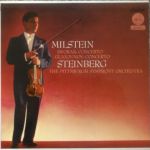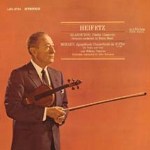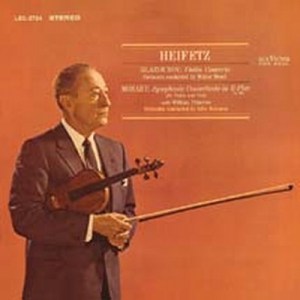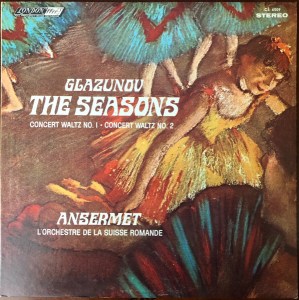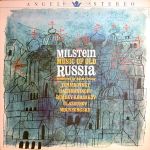 More Classical Recordings Featuring the Violin
More Classical Recordings Featuring the Violin
More of the music of Peter Ilyich Tchaikovsky (1840-1893)
White Hot Stamper sound on side one – the Tubey Magic is off the scale
Milstein is brilliant on these shorter violin works, 7 in all
The orchestral accompaniment is superb, with lovely size and weight
One of the better violin showpiece albums we have yet to offer on the site
This rare, hard to find original Blue Angel stereo pressing has exquisite sound. As we noted in our listing for Milstein’s Saint-Saens Third, it is the rare Heifetz album on Shaded Dog (or any other label) that could hope to compete with it.
We would rank this Angel recording/pressing with the best of Rabin and Milstein on Capitol, as well as the wonderful Ricci and Campoli discs on London/Decca.
The transparency of both sides lets you “see” the orchestra clearly, without sacrificing richness or weight.
What a record! What a performance from Nathan Milstein.
Side One
Music of Rachmaninoff, Mussorgsky, Glazounov and Tchaikovsky
Huge space, super transparent and awesomely dynamic, this side is killer in every way. The sound is as rich and tubey as any Ricci record on London, and that means VERY rich and tubey. I could not find anything to fault in the sound. Superb in every way.
Side Two
Music of Tchaikovsky-Glazounov and Rimsky-Korsakov
Rich and smooth, with good space, but not quite all the phenomenal transparency of side one. Very musical this way, and the music is sublime.
TAS List? Feh!
Definitely side one, and probably even side two of this copy put most of the TAS Super Discs to shame. I would venture to say that there’s a very good chance that you have NEVER heard a violin-led orchestral recording as good as this one. It’s clearly superior to most of what I take to be the pressings that audiophiles cherish for their putatively superior sonics. (Don’t even bring up that crap that Classic Records pressed of the Heifetz RCAs. They may have impressed the critics and the man-in-the-street audiophile but they sure didn’t do much for us.)
[Actually, one of them did. Ah, but which one?!]
The fact that this wonderful sound has been found on a lowly domestic Angel pressing is, to me, the icing on the cake.
TRACK LISTING
Side One
Rachmaninoff – Vocalise
Moussorgsky-Rachmanminoff – Hopak
Glazounov – Meditation
Tchaikovsky – Valse Scherzo
Side Two
Tchaikovsky-Glazounov – Meditation
Tchaikovsky-Glazounov – Scherzo
Rimsky-Korsakov – Fantasy on Russian Themes
Nathan Milstein
There can be no argument about Nathan Milstein’s exalted place in the hierarchy of 20th-century violinists. To many, Mr. Milstein — the last surviving pupil of Leopold Auer, considered the 20th century’s pre-eminent teacher of violin — was the greatest of all exponents of the 19th-century violin repertory, though he played music from Bach to Prokofiev and had achieved a special affinity for the Bach unaccompanied sonatas.
From the beginning, his playing was constantly described as “flawless,” “aristocratic” and “elegant.” A supreme technician, he nevertheless refrained from flaunting his extraordinary bow and finger dexterity. Instead he concentrated on the substance of the music, interpreting it in a warm, unaffected, personal manner. As a Romantic violinist he had in his repertory any number of virtuoso works, including his own “Paganiniana,” a wild melange of violinistic stunts based on the famous 24th Caprice by Paganini. But even in works like these he managed to imbue the music with a kind of elegance that completely transcended any hint of vulgarity.
He could well have been the most nearly perfect violinist of his time. Jascha Heifetz had a more electrifying technique, but there were those who considered him, rightly or wrongly, too cool and objective. Joseph Szigeti, who may have had a more probing musicianship and a wider repertory, never had the tone or technique of Mr. Milstein, who was able to bring everything together in a way matched by very few violinists of his time.
Year after year, Mr. Milstein (pronounced MILL-stine) played in much the same flawless manner, with no apparent deterioration. He never seemed to age. Brown-haired, medium-sized, stocky but never looking stout, he came on stage and, in his imperturbable manner, made music as he always did.
His playing, virtuosic as it could be when the music demanded, always gave the feeling of intimacy. It was characteristic that he elected to use a Stradivarius. The Stradivarius is a more subtle instrument with a smaller sound than the Guarnerius del Jesu instruments favored by more exhibitionistic players.
Joseph Fuchs, the veteran American violinist and pedagogue, said that he had observed some significant changes in Mr. Milstein’s playing during the 50 years they were friends. Mr. Milstein’s tempos were faster when he was young, but as he grew older he slowed down, though he never could have been considered lethargic. But one thing Mr. Milstein always had, Mr. Fuchs said, and that was a natural, unforced way of handling the instrument.
“There is a difference,” Mr. Fuchs said, “between facility and technique. Many violinists have facility. Technique is all-encompassing, taking in finger, bow and everything else. Milstein was a great technician. One reason he played so well at so advanced an age was because of his completely natural way of playing. He never forced the instrument, he never threw his muscles into strained or awkward positions. And as a musician he never stood still. He was always experimenting, changing, probing. He never stopped working.”
To Glenn Dicterow, the concertmaster of the New York Philharmonic and a representative of the younger generation, Mr. Milstein ranked with Jascha Heifetz and Fritz Kreisler as one who set all-time standards.
“Milstein was the complete violinist,” Mr. Dicterow said. “You heard three notes of the man and you knew who was playing. It was pure, uncluttered, honest playing free of any technical problems. He set a standard that nobody today can touch. He had such incredible flow, such incredible fluency. And he always sounded so spontaneous. I know of no other violinist in history who was playing with such security at so advanced an age. He was a tremendous inspiration to me. I idolized that man.”
By HAROLD C. SCHONBERG / The New York Times

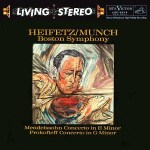 Hot Stamper Pressings Featuring the Violin
Hot Stamper Pressings Featuring the Violin